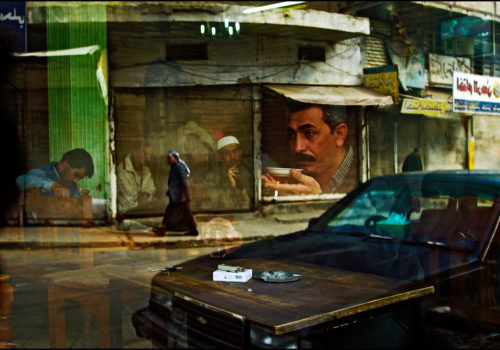This image is taken from Michel Setboun’s third book about agencies. Eighty reporters were chosen to comment on one iconic image taken during their careers. The image we’re publishing today is a picture by Bruno Stevens.
In 2003, two months before the outbreak of the Iraq War, I was in Baghdad. I discovered there a rich, vibrant society that had little in common with the Western media’s simplistic division of the country into Sunnis and Shiites. I wanted to paint a deeply layered portrait of the city to show its diversity. I chose to photograph the cafés because each one possesses a distinct identity and is frequented by particular social groups: poets, police officers, chess players, shopkeepers and so on. To me, this picture could be a metaphor for the whole country. It’s not a picture of a café, but of a society enclosed in a kind of aquarium. At the top right, we can make out a television screen, on which Saddam Hussein’s son is seen delivering a determined speech again foreign influences.
More than ten years have passed since I filed this report, and now I have serious questions about photojournalism. I wonder if I can still express my commitment to issues I care about through the media as it is today. I have a real problem with being in the field and photographing people who think that I’m going to share their suffering with the world, even though I know for a fact that most of the photographs will just be stored away on a hard drive somewhere. Why? Because the magazines that fund my trips can only publish, in the best cases, one or two photographs, which are seen in turn by an already captive audience. I was especially shocked by the hypocritical reactions to the death of Camille Lepage, the 26-year old photojournalist murdered in the Central African Republic in May 2014. The papers fell over themselves to praise Lepage’s incredible work. But where were they before? She was penniless and traveled alone to conflict zones. She was forced to work in terrible conditions. These newspapers are partly responsible for what happened to her.”
Propos recueillis par Laurène Daycard.
















